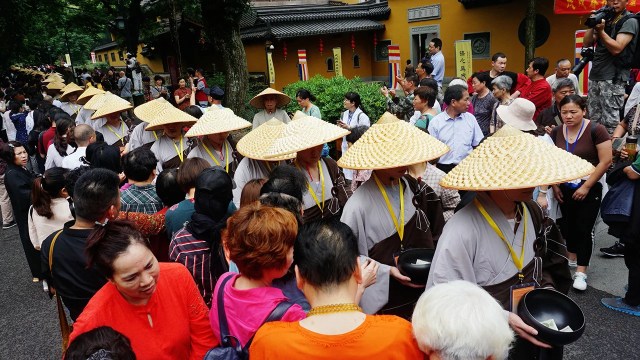
Buddhism (Fojiao 佛教) is the largest officially recognized religion in China. The share of Buddhists in China ranges from 4% to 33%, depending on the measure used and whether it is based on surveys that ask about formal affiliation with Buddhism or beliefs and practices associated with Buddhism.
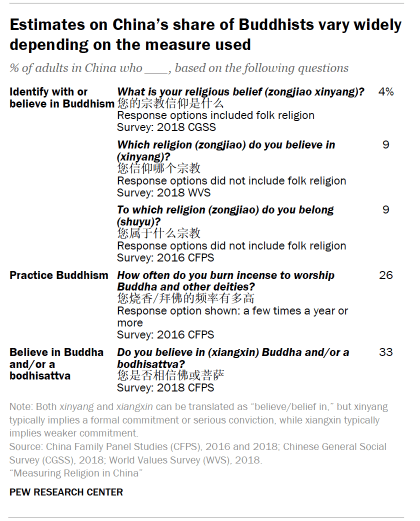
The share of Chinese adults who formally identify (zongjiao xinyang 宗教信仰) with Buddhism is about 4%, representing about 42 million adults, according to the 2018 Chinese General Social Survey (CGSS).39
But 33% of Chinese adults, representing about 362 million adults, believe in (xiangxin 相信) Buddha (fo 佛) and/or a bodhisattva (pusa 菩萨), according to the 2018 China Family Panel Studies (CFPS) survey – though this number also includes many people who believe in other religious figures as well, such as Jesus Christ or Taoist immortals.40
Buddhism in China has three main branches. Han Buddhism, or Chinese Buddhism, accounts for the vast majority of the country’s Buddhists, as measured by the number of registered temples. (Refer to “Geographic distribution of Buddhist temples” for more detail.)
Tibetan Buddhism and Theravada Buddhism are practiced primarily by ethnic minorities in the Tibetan Plateau, Inner Mongolia and along the southern borders with Myanmar, also called Burma, and Laos. In China, the word “Buddhism” typically refers to Han Buddhism.
Buddhism is the oldest “foreign” religion in China, introduced during the Han period (206 B.C.E.-220 C.E.) by traveling monks from India and Central Asia. In its earliest days, it was primarily practiced by foreign monks and merchants. Chinese people were forbidden to build or join monasteries, and Buddha was viewed as a foreign deity.
It was not until the late Han dynasty that Buddhism started to attract Chinese converts and develop into “Han Buddhism” by incorporating concepts and practices from homegrown Chinese traditions. Han Buddhism, currently the dominant strain in China, flourished in the Tang dynasty (618-907), and under imperial patronage, numerous Buddhist temples and shrines were built across the country.41
Tibetan Buddhism is the second largest branch in China, practiced primarily by Tibetan and Mongolian ethnic groups. Since its introduction to the Tibetan Plateau, Buddhism in that area has absorbed the shamanistic features of the indigenous Tibetan religion, Bon.42 Tibetan Buddhism started to spread to other parts of China, particularly the northern regions of Inner Mongolia and Beijing, after being promoted by imperial rulers first during the Yuan dynasty (1271-1368) and later by the Qing dynasty (1636-1911).
In 1959, during the Chinese military’s suppression of Tibetan uprisings against Chinese communist rule, Tensin Gyatso – the 14th Dalai Lama and both a political and spiritual leader of the Tibetan people – fled to India. Since the 1990s, worshipping the Dalai Lama or displaying his image in Tibetan areas has been effectively banned as the Chinese government considers him to be a “separatist.”43
In recent decades, Tibetan Buddhism has gained some influence among the Han majority. Some research suggests that charismatic teachers of Tibetan Buddhism (e.g., reincarnated lamas) and Tibet’s pristine landscape are particularly appealing to Han Chinese in cities.44 Tibetan Buddhist visual symbols, such as thangkas, or scroll art, as well as ritual practices such as mantra chanting, have also generated interest in the religion.
Theravada Buddhism was introduced to China in areas bordering Myanmar, also called Burma, and Laos around the seventh century, though the religion did not gain a large following until the 16th century. It is prevalent among Dai people, who have blended in elements of traditional animist beliefs. Even today, reports indicate that almost every Dai village has a sacred forest where Dai people believe gods and ancestral spirits live. Theravada Buddhists have held on to some old traditions, such as sending boys to be monks for a temporary period, although this practice has come under scrutiny due to the intensifying restrictions on religious education for children.
During the Cultural Revolution of 1966 to 1976, Buddhism was among the primary targets of Communist Red Guards. Buddhist temples and statues were destroyed, and Buddhist monks were forced to return to lay lives.
Although Buddhism originated in India, Han Buddhism has developed distinctly Chinese characteristics while also influencing older Chinese belief systems. Han Buddhists generally espouse the Confucian ideal of filial piety (xiao 孝) and have adopted practices that align with ancestor worship, such as praying for the well-being of deceased ancestors.45 They also have incorporated the Taoist practice of breathing exercises.
In the past decade, government policies have been relatively lenient toward Han Buddhism. President Xi Jinping has extolled (Han) Buddhism as one of the essential forms of Chinese traditional faith with a role to play in restoring morality, and has commended it for having “integrated … with the indigenous Confucianism and Taoism.”
How many Buddhists are there in China?
As with Taoism and folk religion in China, assessing the size of the Buddhist population is challenging due to Buddhism’s blurry boundaries with other traditional Chinese religions. Unlike Christianity and Islam, Buddhism does not require exclusivity of belief or practice. Buddhists do not need to affiliate with a local temple or Buddhist association, nor must they participate in the formal ritual of “taking refuge” (guiyi 皈依) to identify with Buddhism.
As a result, survey questions that measure Buddhist self-identification (i.e., “What is your religious belief?” “Which religion do you believe in?” and “To which religion do you belong?”) fail to capture adults who engage in Buddhist beliefs and/or practices but do not consider themselves formally affiliated with Buddhism. Survey questions that ask about Buddhist affiliation tend to produce much lower estimates than those that ask about belief in Buddha and/or a bodhisattva, or about the burning of incense to pay respects to Buddha and other deities (shaoxiangbaifo 烧香拜佛).
That said, belief and practice measures are not a wholly accurate proxy for Buddhist identity, either. Because of Buddhism’s embeddedness in Chinese folk religion, seemingly Buddhist measures are not exclusively Buddhist, and may also capture folk religion practitioners. For instance, the Buddhist figure of Avalokiteśvara, a bodhisattva often depicted as genderless or male, has evolved into an important folk deity, the goddess of mercy (Guanyin 观音), which makes it unclear whether a person worshipping a bodhisattva is a Buddhist or a practitioner of folk religion. (Refer to Chapter 2 for a discussion of how Buddhism intertwines with other Chinese religious traditions.)
Meanwhile, Chinese people sometimes do not distinguish between certain concepts in folk religion and Buddhism. In southern Fujian, for example, people commonly refer to all types of folk religion as Buddhism (Fojiao 佛教).46 In other words, some people who primarily practice folk religion may choose “Buddhism” as their religious belief (zongjiao xinyang) in surveys, especially when “folk religion” is not offered as an option. Indeed, surveys that give respondents the option to self-identify with “folk religion” tend to produce lower Buddhist estimates than those that do not offer “folk religion” as an option.
Moreover, there is a varied understanding of what it means to “be Buddhist.” Some Chinese who worship Buddha as one of many folk deities may describe themselves as “believing in Buddha” (xinfo 信佛), while those who are devoted to studying Buddhist scriptures may say they are “studying Buddha” (xuefo 学佛) or refer to themselves as “Buddha’s disciples” (fomen dizi 佛门弟子). Others may believe that only Buddhist monks and nuns should claim Buddhism as their zongjiao (宗教) or zongjiao xinyang.
While it may be possible to approximate the number of Buddhists based on the share of adults who engage in distinctly Buddhist rituals and activities – such as “taking refuge” and chanting Buddhist sutras – there is a shortage of data on these measures. The last publicly available national survey to ask questions about clearly Buddhist rituals and activities was the 2007 Spiritual Life Study of Chinese Residents, which found that only a small fraction of Chinese adults had undergone the formal ritual of conversion (2%), recited Buddhist prayers (1%) or occasionally read Buddhist scriptures (1%).
Even the Buddhist Association of China – the official supervisory agency for Buddhist affairs in China – provides population estimates that it says are based on “incomplete statistics” (bu wanquan tongji 不完全统计). In 2017, it estimated that China had more than 100 million Buddhists, equivalent to more than 9% of the adult population. How this estimate was derived is unclear.
Buddhist beliefs and practices
Belief in Buddha
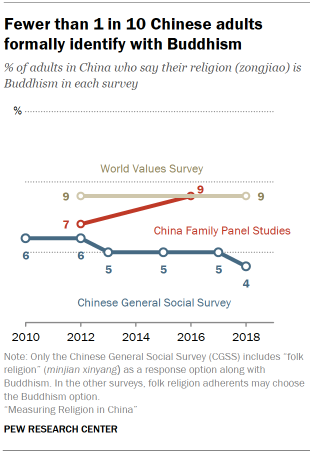
Fully 33% of Chinese adults say they believe in (xiangxin) Buddha and/or a bodhisattva, according to the 2018 CFPS survey.47 This figure includes those who chose one or more additional deities from among the response options, such as “Taoist immortals,” “Jesus Christ,” “Catholic God” and “Allah.” The share of Chinese adults who say they believe in Buddha and no other deities is 16%.
Burning incense to worship Buddha (and other deities)
About a third of Chinese adults say in the 2016 China Family Panel Studies survey they burn incense to worship Buddha and other deities at least once a year (35%), including 26% who engage in such practice a few times a year or more. Again, questions about Buddha – such as those that measure belief in Buddha and/or a bodhisattva or the burning of incense to worship Buddha and other deities – are not distinctly or exclusively Buddhist. (Refer to discussion in previous section.)
Zongjiao affiliation
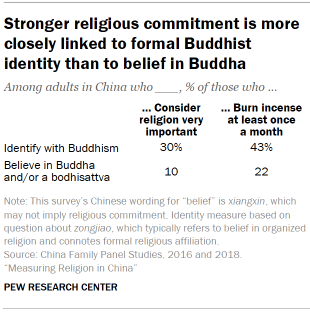
In the 2018 CGSS – which includes a “folk religion” option – 4% of Chinese adults said their zongjiao xinyang is Buddhism. Estimates of Buddhist affiliation from surveys that do not offer the folk religion option, such as the CFPS and World Values Survey (WVS), are as high as 9%.48
One advantage of the CGSS, which is the only survey that includes “folk religion” as a response option, is that it may help differentiate Buddhists from folk religion practitioners who might otherwise choose the “Buddhism” response option. Another advantage of the CGSS is that it measures formal affiliation with Buddhism using similar methods across waves, and it produces Buddhist estimates that do not swing dramatically between waves. The CGSS estimate of the Buddhist population is conservative relative to the other sources, and it seems to trend slightly downward over time.
The WVS and CFPS each have only two publicly available datasets with a consistent measure of Buddhist affiliation. They provide less information about change over time than the CGSS.
As discussed earlier, zongjiao-focused questions do not capture the full scope of traditional Chinese religions, including Buddhism. Still, zongjiao affiliation measures provide useful context.49
Not surprisingly, surveys show that adults who claim Buddhism (Fojiao) as their religion (zongjiao) tend to be more actively engaged in zongjiao religious practice than those who believe in (xiangxin) Buddha and/or a bodhisattva, and they are also more likely to consider zongjiao very important in their lives, according to the CFPS.50
Geographic distribution of Buddhist temples
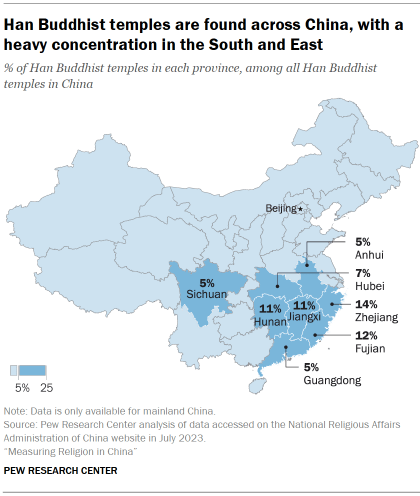
In China, Buddhist temples are known as si (寺) or siyuan (寺院). They often consist of several buildings, including a monument housing a sacred Buddhist relic as well as a monastery or housing for monks or nuns, and a prayer hall that is open to the public for worship.
Simiao (寺庙), which is another term for Buddhist temples, can also refer to any temples or shrines that house Buddhist deities, along with various other traditional Chinese religious deities.
The National Religious Affairs Administration (NRAA), which measures officially registered Buddhist temples with a monastery, found that there are about 34,000 such venues in China.51 Han Buddhist temples are most common (28,528), followed by Tibetan (3,857) and Theravada (1,705) temples.
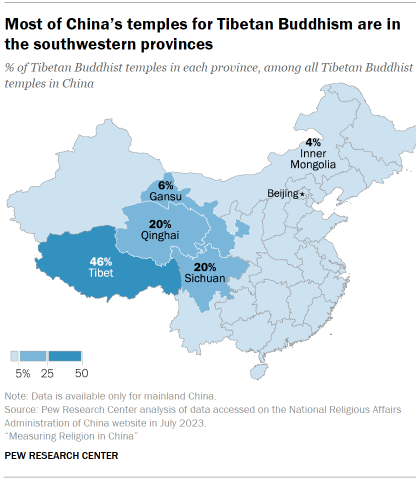
However, these numbers do not include unregistered Buddhist temples. To be officially registered, religious venues in China must meet specific requirements, including having a steady income and qualified clergy. Some temple managers may have little incentive to register because local authorities often permit unregistered Buddhist temples to operate normally (even though they crack down on unregistered churches.)52
Moreover, official statistics fail to count some folk temples (miao 庙) that also house Buddhist deities along with various other traditional Chinese religious deities.
The 2014 China Labor-force Dynamics Survey (CLDS) of neighborhood committees – the smallest administrative unit in China – which asks neighborhood committee staff about the presence of Buddhist temples (simiao) in their jurisdiction, indicates that temples with some type of Buddhist connection are far more common than NRAA data indicates.
A Pew Research Center analysis of the 2014 CLDS suggests that there are at least 192,000 such temples (simiao) dedicated at least partially to Buddhist deities in China, more than five times the officially registered number of Buddhist temples. Officially registered temples usually have resident monks and nuns, which is not necessarily true for unregistered temples. (For more on other types of traditional Chinese worship sites, refer to the “How many Buddhist, Taoist, Confucian and folk religion sites are there in China?” sidebar.)
According to NRAA, Han Buddhist temples are widespread throughout the country, with a heavy concentration in the southeastern provinces of Zhejiang, Guangdong, Fujian, Hunan, Hubei and Jiangxi. This concentration is likely tied to higher rates of economic development in these areas, which may have helped accelerate temple construction and repairs after the Cultural Revolution.
Tibetan Buddhist temples are largely confined to the southwestern region known as the Tibetan Plateau, which encompasses the Tibet Autonomous Region established by the Chinese government in 1965, as well as portions of the neighboring provinces of Sichuan and Qinghai. (In this report, Tibet refers to the Tibet Autonomous Region.) Nearly 86% of China’s Tibetan Buddhist temples are found in Tibet, Sichuan and Qinghai.
All Theravada Buddhist temples registered with the NRAA are found in the southwestern Yunnan province, particularly in areas heavily populated by Dai people, such as Xishuangbanna prefecture.




